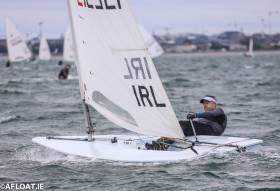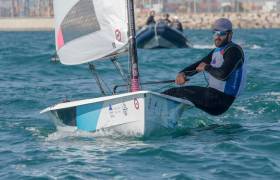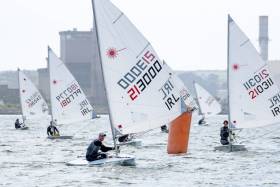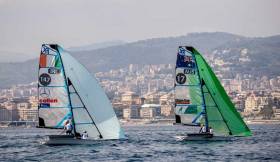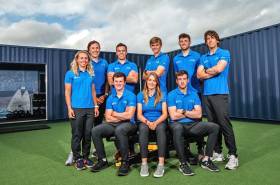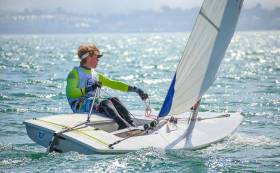Displaying items by tag: Laser Radial
Trading a few years of experience on your rivals isn’t a major problem when you’re on a run of form like George Kingston.
The Royal St George sailor gave a masterclass in race management and consistency last weekend when he strolled to the Laser Leinster title in the waters off Rush.
And the return to Dublin Bay clearly hasn’t broken his stride - finishing Day 2 of the Volvo Dun Laoghaire Regatta with three bullets out of three in the standard rig class.
Clubmate Ross O’Leary and Royal Irish’s Justin Maguire - both of whom were gearing up for a home challenge in the Master Worlds this time last year - were left swapping second and third spots.
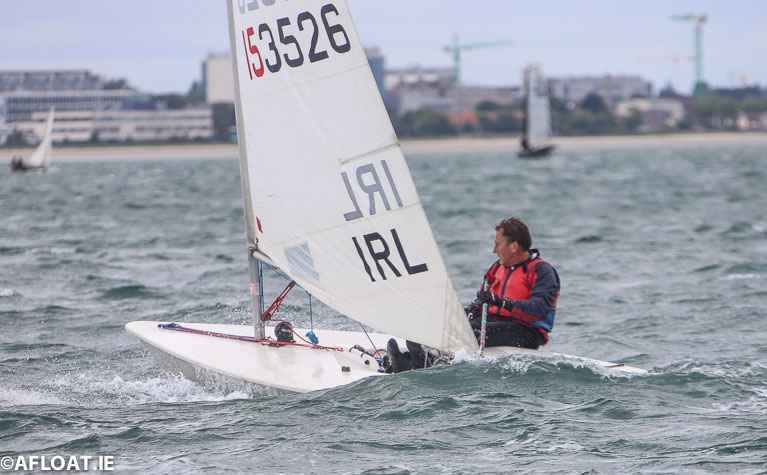 Justin Maguire of the Royal Irish Yacht Club
Justin Maguire of the Royal Irish Yacht Club
Meanwhile in the Radial fleet, Marco Sorgassi tops a runners and riders list that he didn’t even appear on when it went to press, scoring a brace of race wins and a second place.
Rush’s Tom Fox - the only non-Royal St George-affiliated entry in the 10-strong fleet - lies second, with a comfortable five-point gap over next placed Sean Flanagan.
The first big international Laser Masters Championships since the Dublin 2019 Worlds took place in Roses, Spain between June 14th and June 20th. In afternoon sea breezes of 8-20 knots and constant sunshine, 151 Radials and 117 Full rigs competed in the European Laser Master Championships, sailing out of the Grup d’Esports Nautic Roses. Launching from a beautiful Costa Brava beach, the racing was tactically challenging, as the upwind legs were heavily left-side favoured.
Irish sailor Sean Craig (Royal St George Yacht Club) competed in the largest 54 boat Grand Master Radial division, travelling to Roses after a good podium finish at the Barcelona Masters a week previously as Afloat reported here. It wasn’t all plain sailing in Roses for Craig however, with an OCS after his best finish, a 720 penalty in another race and then a nasty incident with a French competitor.
Some better consistency in the latter stages left him 10th overall and 8th European (two Canadians were ahead of him in the Open rankings).
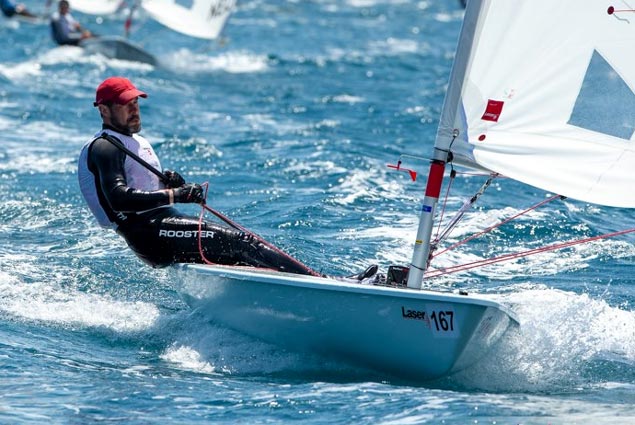 Niall Peelo
Niall Peelo
There was other Irish interest too, with strong performances by two UK-based Radial sailors, both sailing under GBR. In the Masters division, Niall Peelo, originally from Malahide Yacht Club and brother of 2008 Olympian Ciara, placed 12th overall of 35 competitors. Peelo’s results improved consistently as the week progressed. Also in the eight-boat Legends (over 75 division) the winner was Mike Kinnear who started his Laser career many years ago at Ballyholme Yacht Club in Co. Down. This was Kinnear’s first year as a Legend and he claimed the scalp of celebrated octogenarian Peter Seidenberg from the USA, who placed third and has dominated this category in recent years.
European Laser Master sailors will look forward to more great competition at the Worlds in Holland in September, with the 2020 edition following not long after, in Melbourne next March.
Results are downloadable below
RS Sailing has issued an open letter to World Sailing in its bid for the men’s and women’s Olympic single-handed dinghy classes currently appointed to the Laser and Laser Radial.
Late last year the RS Aero was selected along with the incumbent Lasers, the Melges 14 and D-Zero from a total of eight bidders for equipment trials for the 2024 Olympic Games in Paris.
More recently, each of these boats (the incumbents excluded) were evaluated in sea trials for men and women in Valencia, Spain in March of this year.
Further trials will be conducted before a final decision is made by December 2020.
But the directors of UK-based RS Sailing — design and tech chief Alex Southon, commercial chief Jon Partridge, sales director Riki Hooker and c-founded Martin Wadhams — are already making their appeal to World Sailing and its member national associations to see the RS Aero as the future of single-handed dinghy sailing at the Olympics.
The full letter is included below:
Dear Mr President and all,
In the coming days World Sailing will make decisions that are likely to affect our sport for the next couple of decades and we feel it appropriate to share our views.
Over the last twenty‐five years we have created RS Sailing and built it into the world’s leading small sailboat brand. We have changed the face of small boat sailing in many parts of the globe, we have made friends on every continent and shared beers in many sailing clubs. We are proud of RS Sailing’s achievements, made not by a few people but by many sailors who believe our sport can be better.
We have not got everything right, but we have listened to the sailors and done our best to create boats and events that are right for the future of our sport. That is why we’re now the brand leader.
We always knew the decision regarding the Olympic single‐hander would be highly charged and the odds are stacked in favour of the incumbent. But the coming decisions are not just about the Olympians; this universal sector drives the youth pathways and the opportunity to build women’s participation as well. The sport is currently in decline in many regions and we all share the primary responsibility to reverse that trend.
The Evaluation was clear. Detractors will always find details to argue but the fact remains the people involved were unanimous in their view that the RS Aero offers clearly the best opportunity – for the youths, women and Olympians.
The boat is ultra‐light, dynamic and better suited to working with a range of rig sizes for light to heavy sailors. It uses high tech construction for competitive longevity. It is backed by the RS organisation, seen as the most capable of delivering consistent high quality to the world through our existing infrastructure and an international FRAND production network on every continent.
Look what happened to cycling when the equipment became light and sexy – the sport exploded.
Conversely, the current Equipment design is fifty years old and heavy. Whatever the rigs, the hull is heavier than many of the sailors it seeks to serve… Lift your bike, ride your bike and think about it...
The issues between the various organisations that build and manage the current Equipment are well documented and long running. They make life harder for many sailors and organisers. Recent communications make it clear that solutions have not been agreed. The issues and potential for litigation against all parties involved distract from growing our sport and threaten World Sailing’s reputation – indeed sailing’s reputation within the Olympic movement.
So, over to you World Sailing. The experts you selected have told you that the RS Aero is the best Equipment for the future of sailing and we have proved ourselves credible partners. The current Equipment was second ranked, even without factoring in ongoing commercial issues.
You can select new Equipment; you can simply ignore the information laid out by the experts and make no change; or you can take some time to consider what is best for the direction of our sport. A smooth transition is possible – perhaps starting with the women’s fleet or the youth pathway.
We offer you a chance to inspire the next generation.
We offer the RS Aero.
Yours,
Alex, Jon, Riki and Martin
There were three McMahon family members from Howth racing in the Laser Radials at this year’s Irish Junior Championship at Crosshaven. But while youngest Jack had to be content with 13th overall, his cousin Eve was very much in improvement mode as the series progressed, notching three fourth places to finish at fifth overall. This made her winner of the girls’ division by five clear points, and thus well entitled to bring the McMahons a second Junior Sailor of the Month accolade for April.
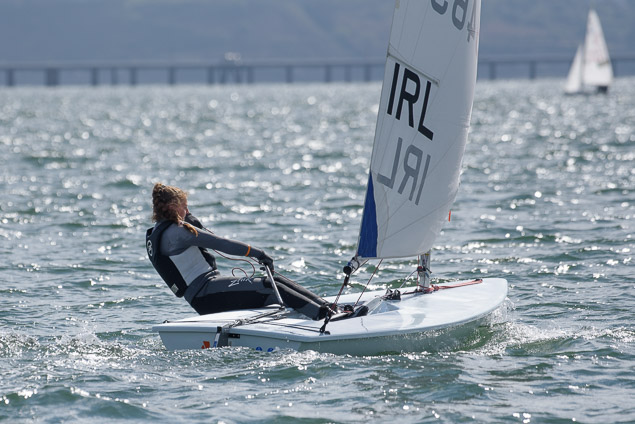 Eve McMahon looking fast in upwind mode Photo: Bob Bateman
Eve McMahon looking fast in upwind mode Photo: Bob Bateman
Jamie McMahon (Howth Yacht Club), put in a convincing performance at the Irish Youth Championships at Royal Cork Yacht Club in the final weekend of April to emerge as Laser Radial overall champion, seeing off some determined challenges from a fleet of 27 from all over the country in a championship contested in decidedly unsettled weather patterns to make him one of two Junior Sailors of the Month for April.
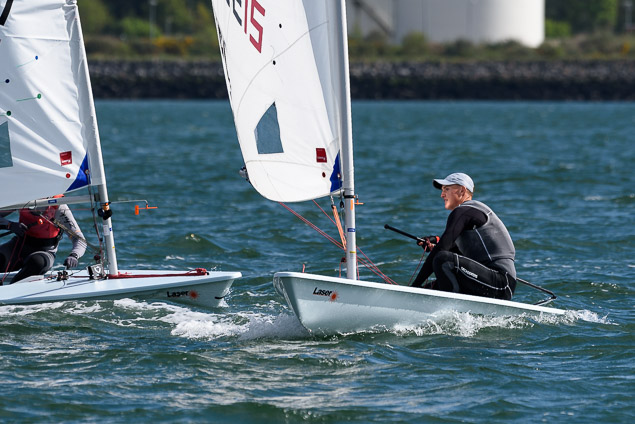 Jamie McMahon negotiates a leeward mark approach Photo: Bob Bateman
Jamie McMahon negotiates a leeward mark approach Photo: Bob Bateman
Laser Radial racing commenced on the third day of competition at Hempel World Cup Series Genoa and Line Flem Høst (NOR) and Switzerland’s Maud Jayet took the first race wins of the series to share an early lead. It wasn't a particularly auspicious start for either of the Irish Radial sailors Aisling Keller (yellow fleet) and Aoife Hopkins (blue) who finished 22nd and 34th respectively. Full results are here.
Of Ireland’s 13 Irish Sailing athletes attending the third event in the World Cup of Sailing series, only the two of the three Men’s 49er skiff crews had a race, while the Women’s Laser Radial event finally got underway but only completed one race.
 The Laser Radial fleet (blue)
The Laser Radial fleet (blue)
Aisling Keller from Tipperary had a 22nd place, while Howth’s Aoife Hopkins faltered at the start in the near flat calm conditions and placed last in the race. Her form recovered to the top 10 in the subsequent race but this was abandoned when the breeze died completely.
Both Women’s Laser Radial single-handers are sailing their first competitive event in six months following their winter training.
In the 49er skiffs, Howth’s Robert Dickson with Sean Waddilove, from Skerries, were penalised for premature starting in their only race of the day. Sean and Tadgh Donnelly, from Dun Laoghaire, had a 28th in the same race, while Ballyholme’s Ryan Seaton and Seafra Guilfoyle, from Cork, had no racing in their flight due to the conditions.
More light winds are expected for Thursday, meaning that the reserve days and weekend will be used to catch-up and deliver on the qualification rounds before Gold and Silver fleet finals.
Radial Fleet Calibre
The 67-boat fleet is split into blue and yellow for the qualification series and the Norwegian triumphed over Greek favourite Vasileia Karachaliou in the blue fleet with Jayet defeating Rio 2016 bronze medallist Anne-Marie Rindom in the yellow.
Only the Laser Radial and the 49er yellow fleet managed to complete a race on Wednesday as a consistent breeze failed to develop. A 3-4 knot southeasterly breeze was just enough for the Laser Radial and 49er to sail. The 470s and Finn will have to wait another day to get their competition underway. Meanwhile, the Nacra 17 remain on three qualification races, the 49erFX on five and the Laser on two.
The calibre of competitors in the Laser Radial is extremely high with numerous Olympic, World Championship and World Cup medallists.
Mistakes can be punished quickly but racing in the yellow fleet, Jayet was near faultless, leading at every mark. “I started quickly,” commented Jayet, “I got out of the pack to sail at the front of the race and managed to beat Anne-Marie.”
Long waits on the water for a sailable breeze to develop can make the mind wander and when racing does start, concentration levels have to rise as the Swiss racer explained, “It is hard to keep focused when everything is going slowly. You have to learn to be patient. As soon as you lose focus you would lose your speed. In days like this, whoever is the most patient will be in front.
“From the start, I try to relax. Instead of running after the gusts, I just wait until I get one. It was one of those days where you could see girls on the other side of the course had more wind but by the time you would get there, it would go. You have to wait your turn and eventually it will come.”
The secret to mastering the conditions and maintain focus is simple, as Jayet continued, “You have to force yourself to sail and train in these conditions. Whenever people see light winds they might not train. You have to train in really light sessions and learn how to stay calm. It’s important to get used to it. None of us can choose what we sail in so we have to try and be good in strong and light winds.”
And as a Swiss sailor from Lausanne, sailing out of Societe Nautique de Geneve, has training and sailing on famous Lake Geneva helped? “I don’t sail on the lake much anymore,” she laughed, “but on days like this, I wish I did more often.”
Jayet took the race win ahead of Rindom with Canadian Olympian Isabella Bertold and Daphne van der Vaart (NED) following.
In the blue fleet, Flem Høst was equally impressive, leading from start, “I managed to separate well from the fleet so I could get some private wind,” explained the Norwegian. “Then it was about staying on top of everyone which I managed to do.”
On keeping focus, the Norwegian had a similar mindset to Jayet, commenting, “It is hard to keep focused. You see everyone coming from behind so it’s important to focus on doing the basics right and keeping calm. I just focused on myself and tried to forget about everyone else.
“You can train the technique in lighter winds, speed, tacks and gybes so you have the right technique but then it’s about breathing right and keeping your cool.”
Greece’s Karachaliou followed Flem Høst into the finish with the experienced Tatiana Drozdovskaya (BLR) and Carolina Albano (ITA) coming through in third and fourth respectively.
Just one 49er race was completed and Croatian World Champions Sime and Mihovil Fantela clinched it, securing their second race victory from three completed so far. Their remaining race result is a disqualification that they picked up in the opening race.
The blue race was the third of the series and does not yet count on the overall leaderboard as the yellow were unable to complete a race on the water. Once their third race is completed the scores will be combined.
Racing is scheduled to continue at 11:00 local time on Thursday 17 April with additional races planned for all fleets in a bid to catch up on those lost.
Two of Ireland’s most promising sailors in Aoife Hopkins and Katie Tingle have been the subject of separate profiles in recent days.
Katie Tingle has been making her big comeback after a broken arm put her and Annalise Murphy’s 49erFX training regimen on pause last autumn.
But it’s also been part of a longer return for the Cork sailor, who swapped competitive racing for coaching after success in the Optimist class as a junior last decade.
A reconnection with former junior peer Annalise on the Wednesday night scene in Dublin led to a fateful phone call a year ago, from the Olympic silver medallist to the primary school teacher: did Katie want to join her 49erFX Olympic campaign?
“I don’t think she’d have asked me if she didn’t think I could do it and I wouldn’t have said yes if I didn’t think deep down that I could do it either,” Katie tells The42.ie.
The 29-year-old was already deep into training and conditioning when Annalise returned from her stint in the Volvo Ocean Race, and the two started getting to grips with their new boat on Dublin Bay — the Olympian learning from Katie who had previous experience in two-handed dinghies.
However, a freak incident just weeks into training left Katie with a broken arm — and out of the water for four crucial months.
As needs must, Annalise shortly after resumed training over the winter in the warmer climes of Portugal, with Adam Hyland in Katie’s stead — while Katie hit the gym as soon as doctors allowed get back on the road to sailing fitness.
Earlier this year Annalise and Katie, how fully healed up, reunited and got back in their groove with the challenging 49erFX as their first big test — and first Tokyo 2020 qualifier — looms in Genoa just two weeks from now.
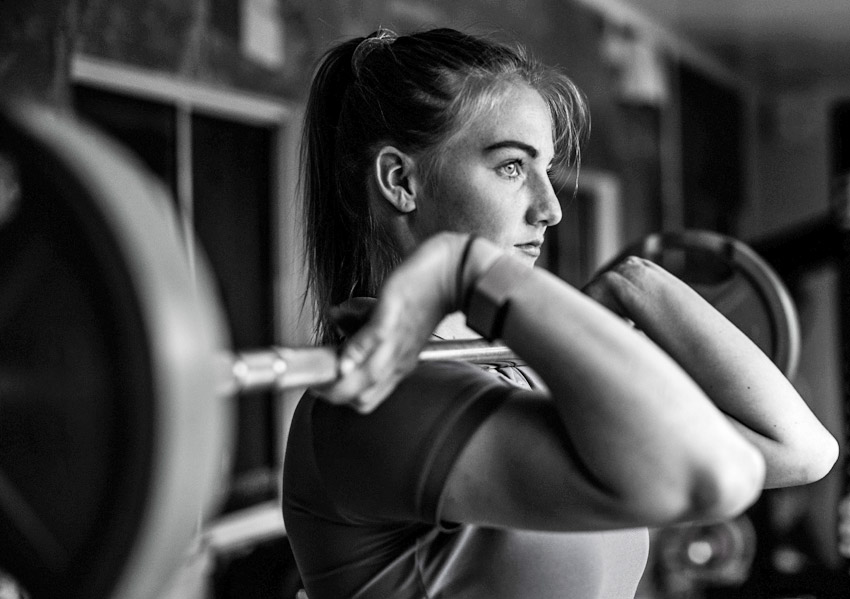 Aoife Hopkins weight training | Photo: Irish Sailing
Aoife Hopkins weight training | Photo: Irish Sailing
Another young sailor who faces a big test in Genoa is Howth Yacht Club’s Aoife Hopkins.
The Laser Radial ace not only steps into the significant gap left by Annalise Murphy, whose Rio 2016 silver medal was in the class — she’s also in competition with teammate Aisling Keller for the single slot available to Ireland.
Aoife tells The Irish Times how she juggles the training regimen of her Tokyo 2020 campaign with the demands of her maths degree at Trinity College, not to mention the various expenses associated with performance sailing at the highest level.
In a boost to their aspirations, Aoife and her fellow performance sailors now benefit from Irish Sailing's new Performance Headquarters in Dun Laoghaire, as previously reported on Afloat.ie.
Laser Dinghy Christmas Specials From CH Marine
As the days tick down to Christmas 2018, CH Marine Chandlery still has some special deals on Laser dinghies — but act fast as these offers are only available till Monday 24 December.
For just €6,950 (£6,185.50) including VAT you could have a standard Laser, Radial or 4.7 with XD rig and composite upper.
And that’s not all, as the price includes a trolley, top cover and foil bag, with sails fully numbered.
These popular packages have been selling fast and as of this morning (Thursday 20 December) there is only one Laser 4.7 deal remaining. If it’s what you’ve been looking for, don’t be disappointed this Christmas!
Be sure also to check out CH Marine’s daily deals on Facebook in the run-up to Santa’s arrival. Today you could save €70 on a Crewsaver Ergolift Offshore Lifejacket Auto 190N with light and hood.
Shop online at CHMarine.com or in store in Skibbereen, Cork and Newtownards — open from 9am to 2pm on Christmas Eve for any last-minute stocking-stuffers!
A Boat For All Ages? Surge Of Laser Radial Entries In 2018 DMYC Frostbites Boosts Ranks With Youths, Women & Older Sailors
More than 40 Lasers have been registered thus far for the DMYC Frostbites, with entries still open online ahead of the series kickoff this Sunday 4 November.
The tally of 46 pledged for the latest Dublin Bay winter series is already way up on last year’s total — and even more interesting is that 24 of them are Laser Radials, showing a boost of interest among women, older and youth sailors.
In particular, the Dun Laoghaire Combined Clubs’ youth training programme is sending as many as eight Radials to this year’s Frostbites, along with a group of 4.7s.
It’s being hailed as a positive sign for the class which has long experienced difficulty in persuading parents and coaches to encourage their children to compete in local racing rather than training.
The impact of the recent Laser Master Worlds in Dun Laoghaire will also be felt with a strong contingent of older sailors in the Radial class this year.
With the final numbers looking to be a field that’s one-third Laser Radials, it could be marking the resurgence of the class often thought of as only a youth boat as one for all ages.
Conway, Bateman & Kohl Top 2018 Laser National Rankings
#Laser - Fionn Conway, Chris Bateman and Atlee Kohl top the tables of their respective fleets in the final Laser class national rankings for 2018.
In the standard rig, the National Yacht Club’s Conway stormed ahead of names very familiar to Afloat.ie readers, from Liam Glynn (3rd) to Ewan McMahon (11th) and Johnny Durcan (14th), to list but a few.
In the Laser Radial, Royal Cork sailor Chris Bateman’s strong results at this year’s regionals put him clear of a strong youth fleet — Jamie McMahon (5th), Aisling Keller (7th), Michael Carroll and Michael O’Suilleabhain (2nd and 9th) included.
And in the Laser 4.7, Bateman’s 29er partner Atlee Kohl ends the year eight points ahead of class newcomer Alana Coakley.


























